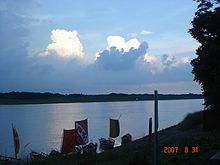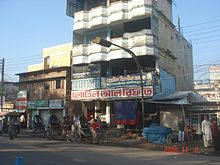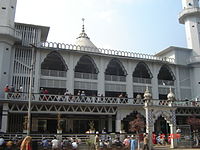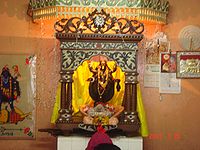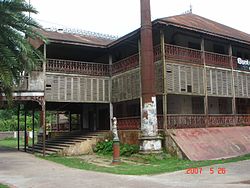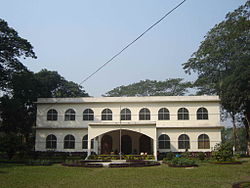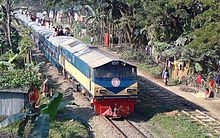- Mymensingh
-
Mymensingh
Momenshahi/ময়মনসিংহ— Metropolis — Monument For Liberation War of 1971, Sombhugongh, Mymensingh. Nickname(s): Moy-mon-singha Location of Mymensingh in Bangladesh Coordinates: 24.6343°0′0″N 90.2677°0′0″E / 24.6343°N 90.2677°E Country  Bangladesh
BangladeshDivision Dhaka District Mymensingh District Establishment 1787[1] Granted city status 1787[2] Government - Type Municipalities - City Mayor Ekramul Haque Titu (Re-elected 2011)[3] - Member of Parliament Al-haj Principal Motiur Rahman Population - Total 330,126 Time zone BST (UTC+6) Postal code 2200 GDP (2005) $XX billion Calling code 91 Mymensingh (Bengali: ময়মনসিংহ), pronounced moy-mon-shing-haw, is a city of Bangladesh situated on the river Brahmaputra. It is the headquarters of the administrative unit Mymensingh District. Mymensingh is the anglicized pronunciation of the original name Momenshahi, referring to a ruler called Momen Shah.[4] The cadet college established in Tangail in 1963 was called Momenshahi Cadet College.[5] The city is known for educational institutions like Bangladesh Agricultural University, Mymensingh Medical College[Mymensingh Engineering College][Mymensingh Ananda Mohon University College][Mymensingh Muminunnesa Women College] Mymensingh Poly technique Institute and Mymensingh Girls' Cadet College. Other landmark institutions include Mymensingh Army Cantonment. Also it is related with old Brahmaputra river, handcrafted duvet called Nakshikantha and a rural ballad called Moimonsingho Geetika. Mymensingh city is located about 120 km (75 mi) north of Dhaka which is the capital of the country.
History
Main article: History of MymensinghMymensingh is one of the 16 old districts of Bangladesh which was constituted by the British East India Company on 1 May 1787.[6] Being more than 220 years old, Mymensingh has a rich cultural and political history. At the beginning Begunbari was chosen as the headquarters of the district. However the district headquarters was relocated to Mymensingh when Begunbari devastated by flash flood. Earlier Mymensingh was called Nasirabad.[7] During the British Raj most of the inhabitants of the town were Hindus.
From the early 20th century Muslims moved into town. Since then this city has played an important role as a center for secularism. The Vidyamoyee Uccha Balika Bidyalaya and Muminunnesa Women's College have played a great role in educating Bengali Muslim women. A majority of first-generation successful Bangladeshi women have attended these schools and colleges, including the first woman justice of the High Court of Bangladesh, Justice Nazmun Ara Sultana.[8] However, many Hindu families left Bangladesh during the partition of India in 1947. A second spell of exodus took place following the Indo-Pak war of 1965. Many people born and raised Mymensingh have left for West Bengal since the 1960s. The exodus continues albeit at a slower pace.
The nine-month liberation war of Bangladesh started on 27 March 1971. Mymensingh remained free from the occupation army until 23 April 1971. Pakistani occupation forces deserted Mymensing on 10 December, and Mukti Bahini took over on 11 December, just five days ahead of the victory of Dhaka on 16 December.
Geography and climate
The city has no officially defined geographical limits. Since 1980s the city has expanded with fast urbanization. Mymensingh city is clearly marked by the old Brahmaputra river flowing along its north. Shambhuganj is situated on the other side of the Brahmaputra, connected by the Shambhuganj Bridge. Other ends of the city are marked respectively by the beginning of the Agricultural University campus, the Medical College, Army cantonment and, finally, Sultanabad, a township built for the followers of Aga Khan. A railway line connecting Dhaka with northern districts, built between 1885 and 1899,[9] passes through the city and divides it into two sides.
The climate of Mymensingh is moderate, much cooler than Dhaka, as it is closer to the Himalayas. The monsoon starts in May or June and continues till August. It rains heavily and sometimes for days and weeks. During the monsoon, the temperature varies between 15 and 20 degrees. The temperature falls below 15 °C (59 °F) in winter which is spread over December and January and may well include November and February. The highest temperature is felt during April–May period when the temperature may be as high as 40 degrees. High humidity causes heavy sweating during this period. For western travelers, the best time to visit is between November and February.
Economy
Historically, Mymensingh district was known for jute production which was termed 'golden fiber' due to revenue it generated as a cash crop. Due to the high demand for polythene bags and other economic reasons, the jute industry has been significantly declined today. Agriculture is the most important sector contributing to GDP, followed by the growing service sector in the city. The increasing demand for fish in the local and global markets has generated a new opportunity for local fishermen as well as businessmen to exploit fishing in Mymensingh and today it is very important to the economy. People have changed their paddy fields to ponds, and are cultivating fish. Prawns, sometimes reaching a very large size in the winter, are sold in Mymensingh in great numbers. The entire area between Durgabari Road,and Maharaja Road comprises the traditional shopping area. There are places like Ganginarpar, Boro Bazaar, Choto Bazaar, Mechua Bazaar within this area. There are spots like Jilapi Patty which is for making and selling jilapi. The main road from Notunbazar to the railway station hosts a number of shops for manufactured products and clothing on the two sides. The old colonial brothels in a moderate Muslim country is a paradox, involving prostitution, drugs and crimes.
Public utilities
Main article: Public utilities of MymensinghCuisine
The staple food is plain rice with a curry of fish or meat. Normally people start with fried or steamed vegetable and dal, a kind of lentil soup. Often people squeeze a lemon slice or take additional salt while eating and add fresh onion rings and green pepper to spice up the food. Traditional snacks and savories include seasonal pitha of various kinds, dal-pury, singara and samosa. Home made desserts include Kheer, Payesh and Shemai. Sweets soaked in syrup of sugar, such as Geelapi, are mostly bought from shops. Paan, a digestive made out of betel nuts, spices, tobacco, and certain other ingredients are eaten by many people, some of which consume it with aromatic Jarda. For dinner or lunch, a simple formula is to prepare "khichdi", the broth of rice and lentils, seasoned with spices, and served with chutney or pickles. Ghee (butter) may be spread just before eating. The meal may end with sweet curd. Muri (puffed rice), chira (flattened rice) and khoi (popped rice/rice krispy) are substitutes for rice. They are eaten with gur (jaggery) which is a kind of unrefined sugar. They may be mixed up with curd or milk before eaten.[4] People use only right hand for eating. No spoon, fork or knife is used.
Religion
- Mosques, temples, and churches
Mymensingh is one the cities in Bangladesh where Muslims and Hindus band together. All types of religious festivals are celebrated throughout the city. During different critical international religious conflicts, people of this city proved what religion means to their lives.
- Anjuman Eid-gah Maidan
Under the auspices of the governor of East Pakistan Abdul Monayem Khan, a prayer ground was established in 1962 on 27 acres (110,000 m2) of land, including a pond. Every year congregation of Eid ul-Fitr and Eid ul-Adha are held here in the morning. The prayer ground is walled on all the sides and has a nice view with coconut trees lining up the sides. This place was used to accommodate the Elephants of Maharaj Surya kanta achrya in colonial time.
- Ramakrishna Math & Mission
Ramakrishna Ashrama of Mymensingh is situated at 182, Ramakrishna Mission Road. Ramakrishna Math is a monastic organization for men brought into existence by Sri Ramakrishna (1836–1886), the great 19th century saint of Bengal who is regarded as the prophet of the Modern Age. Ramakrishna Mission is a registered society in which monks of Ramakrishna Math and lay devotees cooperate in conducting various types of social service. It was founded by Sri Ramakrishna's chief apostle, Swami Vivekananda (1863–1902), one of the foremost thinkers and religious leaders of the present age, who is regarded as 'one of the main moulders of the modern world', in the words of an eminent Western scholar A. L. Basham.
Landmarks
The Old Town Hall, built by Maharaja Surya Kanta Acharyya had hosted thousands of drama, meeting and cultural functions since 1878. The age old Town Hall was demolished in 2006 and is being rebuilt by the Mymensingh Pourashava.[10]
Bangladesh Parishad, situated at Chhotto Bazar Road, the regional center of Pakistan Council in Mymensingh, set up in 1969, came to be known as Bangladesh Parishad after establishment of Bangladesh in 1971. It was a government institution under the Ministry of Information and housed a public library with a good collection of books and magazines. The library has 35,656 volumes on all subjects.[11] It also had a hall to hold literary and cultural functions. Till 1980s, Bangladesh Parishad was a hub of cultural activity of post-liberation Mymensingh. It was most active in the late 1970s when Ashraf Ali Khan was its chief executive.
Shishu Academy was set up under the initiative of president Ziaur Rahman in 1980. Its Mymensingh office was opened in 1990s.
The first Shahid Minar was built in 1958 on crossing of the Amrita Babu Road, close Mymensingh Pourashava. It was relocated to the Ton Hall premises around mid-1990s.
Amarabati Natya Mandir was the first theater built in the heart of Mymensingh town in 1930s. Later it was considerted into a cinema named Aloka. The Town Hall became the sole venue for staging a play or drama. Bahubrihi is one of the drama circles that has played a key role in sustaining the drama movement in Mymensigh since 1970s.[4] Singing was part of daily life for most people since the 19th century. Mithun Dey and Sunil Dhar were two popular music teachers since the 1960s. Sunil Dhar established a music school at Atharo Bari Building in the 1980s. Folk Ballads: Maimansingha Gitika. There are five cinema halls in Mymensingh town. Most of these halls are very old but still in operation. Cable TV connectivity was launched in 1999 and together with DVD and VCR, most people now prefer home entertainment. However, on special occasions such as Eid, new year, Puja, and other vacations, people still watch movies in the cinema halls. Aloka was the oldest cinema hall which was demolished in 2006 to make a modern shopping and residential complex. Other cinema halls are Chayabani, Purabi and Shena Nibash.
Muslim Institute library has been the most popular public library, established in 1934. The Bangladesh Parishad library was rich and popular which died down in the 1980s. The local Bar also has a library of its own rich in legal books and journals.
The "Alexandar Castle" or "Lohar Kutir" as it is locally known, is where Maharaja Surya Kanta Acharya invited Russian Jar Alexander and built it for his stay and a same Russian styled also built by the Ponni of Tangail. Rabindra nath Thakur also was in Alexandra castle for participating a citizen gathering. This earthquake-proof steel and timber building was built after his much vaunted "Crystal Palace" or "Rang Mahal" as it was locally known, was totally and completely destroyed by the "Great Bengal Earthquake" of 12 June 1897. Subsequently, "Soshi Lodge" or "Mymensingh Palace" was built at the site of "Rang Mahal". However Maharaja Surya Kanta died before "Soshi Lodge" could be completed. It was completed by Maharaja Soshi Kanta Acharyya. Both the buildings had once contained innumerable works of art, artifacts, sculptures and antiques collected from all over the world. Both these buildings have been declared as National Heritage Monuments. But unplanned development already damaged the scenario of rare Russian architecture in this country.
Bipin Park is a small park near Boro Bazaar right on the Brahmaputra river.
- Museums
The Mymensingh Museum was established in 1969. Though its collection comes from the palaces of zamindars of the greater Mymensingh region, it lacks proper preservation.[12]
The Zainul Abedin Museum was established in a house on the Brahmaputra River in 1975. The art gallery includes the paintings of Zainul Abedin, a pioneer of the country's modern art movement, as well as an art school, art cottage, and open-air stage.[13][14][15]
Sports
The "Panditparar Math" is a vast field on the bank of the Brahmaputra, in front of the Circuit House, which is used by the sports persons of the city. It has produced many notable cricket players like Prabir Kumar Sen, one of the few wicket keepers to stump Don Bradman and Hemanga Bose. It is also used for holding large public meetings.
Body building has become a favourite pastime for many of the young adults of the town. The Muslim Institute has a well equipped gymnasium since 1950s. Although the zeal and enthusiasm observed in earlier times had significantly died down by the 1990s, young adults still visit this gymnasium on a regular basis for a work-out. Physician Abdul Halim was a renowned bodybuilder in the 1960s who became Mr. East Pakistan in a nationwide competition. Farhad Ahmed Kanchon, who later became a Member of the Parliament in late 1970s, was also a regular.[4]
Education
Main article: List of universities and schools in MymensinghMymensingh contains many universities, colleges and schools. Of particular note are Bangladesh Agricultural University, Agricultural University College, Mymensingh , Shahid Syed Nazrul Islam College, Mymensingh Medical College, Muminunnesa Women's College, Jatiya Kabi Kazi Nazrul Islam University, Mymensingh Girls' Cadet College, Mymensingh Engineering College, Mymensingh Zilla School, Mukul Niketon School, Ananda Mohan College, Katlashen Kaderia Kamil Madrashah, and Al-Arabia Dakhil Madrashah. For computer education is the best institute is
- RANA COMPUTER INSTITUTE
Transportation
The distance from Mymensingh to Dhaka is about 120 km (75 mi) from the Mohakhali bus stop.The city was linked with Dhaka after the railway lines were connected around 1865. The road link to Dhaka was via Tangail until 1979 when president Ziaur Rahman ordered the completion of the half-finished highway between Dhaka and Mymensingh via Bhaluka. In 2006, the bus fare in the city was around TK.105 (US$1.5) per person, and around Tk.120 ($1.71) in January 2010. However, rickshaw is the main mode of transportation within the city area and the growth of the number of cars is relatively slow. Three-wheelers started to ply toward the end of 1990s.
Train is by far the cheapest means to get to Mymensingh. Apart from a number of local trains, Ekota Express, Aghnibina Express, Tista Express, Bhrammaputra Express, Jamuna Express and Balaka Express connect the town with the capital of Dhaka. Train fares range from 40 tk to 120 tk ($0.57 to $1.71) per person depending upon the class and the train itself. It takes almost 3 hours to reach Mymensingh from Dhaka by train. All intercity trains connect the city with Jamalpur town as well. Several local trains run between Mymensingh town to Kishorganj and Netrokona.
Health care and cemeteries
Maharaja Suryakanata set up the first public hospital in Mymeninsingh along the river Brahmaputra. This is now a leprosy hospital. Mymensingh Medical College hospital is now serving the local people as well the people of surrounding districts.It is one of the oldest and biggest hospitals in Bangladesh.Since end of 1990s, private investment in the medical sector has gone up and a number of private hospitals of various sizes and clinics have been established. Situated over about 40 acres (160,000 m2) of land, the Golkibari Cemetery is the largest Muslim cemetery of the town. There is another Muslim graveyard at Kalibari named Kalibari Gorosthan. The Hindu Shmoshanghat in Kewatkhali by the side of Brahmaputra railway bridge and the Christian cemetery of the colonial British are also present, and various other smaller cemeteries.
Media and literature
Bharat Mihir was one of the oldest newspaper ever published from Mymensingh in British India. Its publication commenced in 1875. After independence in 1971, Habibur Rahman Sheikh published in 1979 the first daily under the name and title Dainik Jahan, following his decade-long trial with weekly Banglar Darpan which had been launched in 1972. He also published a women's monthly under the title Chandrakash for almost a decade. The other newspapers published from the city include Dainik Ajker Bangladesh and Dainik Aker Khabar.[4] Newspapers published from Dhaka came by train and was available around the noon till 1980s. Hawkers riding bicycle would deliver newspapers from home to home by the afternoon. As the roadlink with Dhaka improved, buses were used for transportation of Dhaka newspapers. Now newspapers from Dhaka arrive Mymensingh by 9.00 in the morning and are delivered to homes by the noon.
Mymensingh Press Club, situated near Ganginarpar is a vibrant hub for the intellectuals, teachers, literature and cultural activists, in addition to media peoples. It hosts literary events, cultural functions and such other activities on a regular basis. Mymensingh Press Club was established towards the end of 1959. It was set up in course of a provincial conference of journalists and editors of the-then East Pakistan, held on 7–8 March 0f 1959. Literary circles of note were Sahitya Sava and Troyodaosh Sammilini. Earlier, in 1960s, a leader of the Ahmadya community, Ahmad Toufiq Chowdhury, had set up printing press in his residence at Maharaja Road to bring out a periodic magazine entitled Writupatra.[4] Poets Musharraf Karim and Farid Ahmed Dulal and writer Iffat Ara are some of the important literary names from Mymensingh. In 1985, Ara set up a press in her own residence to bring out the monthly Dwitiyo Chinta.
Notable personalities
Reference to Mymensingh has multiple meaning. It may refer to the original Mymensingh district comprising Netrokona, Jamalpur and Kishoreganj as well as Tangail. It may also refer to Mymensingh town per se in a narrow sense.
An Indian scientist of the last century, Sir Jagadish Chandra Bose was born in Mymensingh on 30 November 1858.[16] The name of Mymensingh is associated with people like anti-British leader Mahadev Sannyal, writer Upendra Kishore Roychowdhury, Sukumar Roy and Leela Majumder, musician and a disciple of Rabindranath Tagore Sailaja Ranjan Majumder, Maharaja Surya Kanta Acharyya, Maharaja Soshi Kanta Acharya, Maharajkumar Sitangshu Kanta Acharya, Maharajkumar Snehangshu Kanta Acharya, Maharaja Brojendra Kishore Roy Chaudhuri, painter Shilpacharya Zainul Abedin, ballad collector Sirajuddin Kashimpuri, noveslist Shirshendu Mukhopadhyay who received early education in Mymensingh town,[4] Humayun Ahmed who is arguably the most popular Bengali writer, acting president of Bangladesh during the war of liberation Syed Nazrul Islam in addition to three other presidents of the country, namely, Justice Abu Sayeed Chowdhury, Ahsanuddin Ahmed Chowdhury. Names of renowned politician and author Abul Mansur Ahmed, the-then Governor of East Pakistan Abdul Monem Khan, educationist principal Ibrahim Khan, president Shahabuddin Ahmed, Language Hero and veteran Politician Khaleque Nawaz Khan, poets Nirmalendu Goon, Helal Hafiz, Musharraf Karim, and Abid Azad, singer Mitali Mukherjee, writers Jatin Sarker, Ghulam Rabbani an Urdu speaking Bangladeshi, author of first Urdu-Bangla and Bangla-Urdu dictionary, played important role to maintain communal harmony during 1964 riots and 1971 liberation war.
Golam Samdani Quraishy, writer, founder GS-BCUTA; Shahid Akhand, Helena Khan, and Iffat Ara[17] and several national and international cricketers like Prabir Kumar (Khokan) Sen, one of the few wicketkeeper to stump Don Bradman and football players, Jahurul Islam one of the wealthiest persons of Bangladesh of 1970s are associated with Mymensingh: The Oscar-winning Indian filmmaker Satyajit Ray and Bollywood actress Rani Mukherjee's family hail from this district. Taslima Nasreen, the feminist writer and critic of Islam, and a well-known and revered physician of Jhansi, India, Dr. Sudhangsu Mohan Bhowmick of Lytton Medical School and his late wife Ina were born and brought up here. Dr. Subhrangshu Kanta Acharya, the Director General of Geological Survey of India and the renowned chemist and engineer, Satrughna Kanta Acharya originated from the district. Bhola is from the house across the street from the fire station.
Gallery
Jalchap-A Vedio Documentary on Mymensingh

For Watching this Vedio Please click the below links:
References
- ^ List of cities and towns in Bangladesh, Retrieved December 29, 2009
- ^ "Speech of Mayor on Spacial Intarnational Working Conference". Chittagong City Corporation. http://www.ccc.org.bd/mayors_hague.html. Retrieved 2009-12-21.
- ^ "AL retains majority, BNP fights back". http://www.daily-sun.com/index.php?view=details&type=daily_sun_news&pub_no=101&cat_id=1&menu_id=1&news_type_id=1&index=0. Retrieved 2011-01-18.
- ^ a b c d e f g Iffat Ara, 'Mymensingh-er Etihash', Dwitiyo Chinta, 1989, Mymensingh, Bangladesh
- ^ Mirzapur Cadet College
- ^ Jaffar Ahmed Chowdhury, Moymonsingha, (Bengali), 2004/2006, p. 13, p. 30-31, Silicon Plaza, Apartment 5A, House 31A, Uttara, Dhaka, ISBN 984 32 1057 3
- ^ http://www.1911encyclopedia.org/Mymensingh
- ^ "First woman in Bangladesh high court". BBC News. 28 May 2000. http://news.bbc.co.uk/1/hi/world/south_asia/767801.stm. Retrieved 19 May 2010.
- ^ http://www.railway.gov.bd/brief_history.asp
- ^ http://www.dgmarket.com/eproc/np-notice.do?noticeId=2379464
- ^ http://www.thedailystar.net/starinsight/2007/08/02/journey.htm
- ^ http://www.thedailystar.net/2006/08/21/d608211402151.htm
- ^ "Shilpacharya enriched country’s history of art". The Independent. January 1, 2011. http://theindependentbd.com/national/26773-shilpacharya-enriched-countrys-history-of-art.html. Retrieved 6 March 2011.
- ^ "Shilpacharya Zainul Abedin Museum". Banglapedia. http://www.banglapedia.org/httpdocs/HT/S_0391.HTM. Retrieved 6 March 2011.
- ^ Islam, Aminul (April 29, 2007). "Shilpacharya Zainul Abedin Sangrahashala - Preserving Works of a Maestro". Star Campus (thedailystar.net) 2 (16). http://www.thedailystar.net/campus/2007/04/05/camspotlight.htm.
- ^ http://www.encyclopedia.com/doc/1G2-3404700801.html
- ^ http://www.thedailystar.net/starinsight/2007/02/01/she.htm
Further reading
- Khan Mohammad Abdullah, Moymonsigh-er Etihash, 1966, Mymensingh, Bangladesh.
- Darji Abdul Wahab, Moymonsigh-er Choritavidhan, 1986, Mymensingh, Bangladesh.
- F. A. Sachse, Mymensingh Gazeteer, BENGAL SECRETARIAT BOOK DEPOT, 1917, Calcutta.
- Asoke Mitra, Towards Independence - 1940-1947", 1997, New Delhi.
- Kedarnath Mojumder, Moymonsingh-er Biboron, 1987, Mymensingh.
- Kedarnath Mojumder, Moymonsingh-er Etihash, 1987, Mymensingh.
External links
- Mymensingh travel guide from Wikitravel
- Mymensingh in Banglapedia
- Telephone Index Mymensingh
- Mymensingh WEB Portal
Cities of Bangladesh Barisal • Bogra • Chittagong • Comilla • Dhaka • Faridpur • Jessore • Khulna • Maulvi Bazar • Mymensingh • Narayanganj • Rangpur • Rajshahi • SylhetCoordinates: 24°45′14″N 90°24′11″E / 24.75389°N 90.40306°E
Categories:- Populated places in Mymensingh District
- Mymensingh town
Wikimedia Foundation. 2010.




